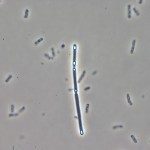Link to Pubmed [PMID] – 35372114
Link to DOI – 10.3389/fcimb.2022.849915
Front Cell Infect Microbiol 2022 ; 12(): 849915
Many bacterial species, including several pathogens, can enter a so-called “viable but non-culturable” (VBNC) state when subjected to stress. Bacteria in the VBNC state are metabolically active but have lost their ability to grow on standard culture media, which compromises their detection by conventional techniques based on bacterial division. Under certain conditions, VBNC bacteria can regain their growth capacity and, for pathogens, their virulence potential, through a process called resuscitation. Here, we review the current state of knowledge of the VBNC state of Listeria monocytogenes (Lm), a Gram-positive pathogenic bacterium responsible for listeriosis, one of the most dangerous foodborne zoonosis. After a brief summary of characteristics of VBNC bacteria, we highlight work on VBNC Lm in the environment and in agricultural and food industry settings, with particular emphasis on the impact of antimicrobial treatments. We subsequently discuss recent data suggesting that Lm can enter the VBNC state in the host, raising the possibility that VBNC forms contribute to the asymptomatic carriage of this pathogen in wildlife, livestock and even humans. We also consider the resuscitation and virulence potential of VBNC Lm and the danger posed by these bacteria to at-risk individuals, particularly pregnant women. Overall, we put forth the hypothesis that VBNC forms contribute to adaptation, persistence, and transmission of Lm between different ecological niches in the One-Health continuum, and suggest that screening for healthy carriers, using alternative techniques to culture-based enrichment methods, should better prevent listeriosis risks.


